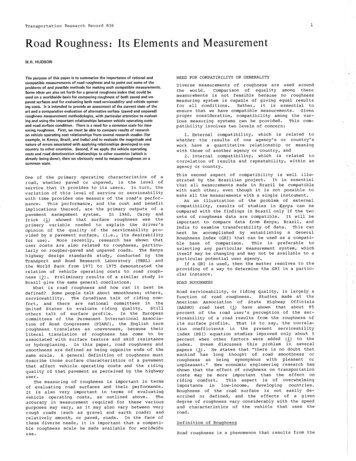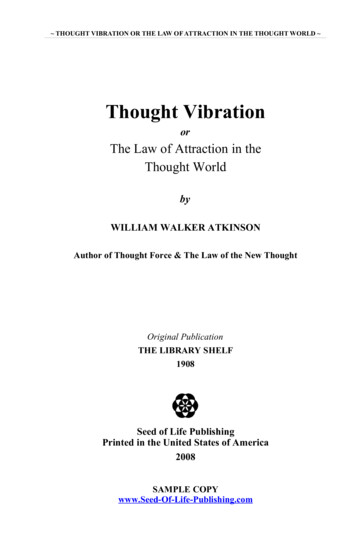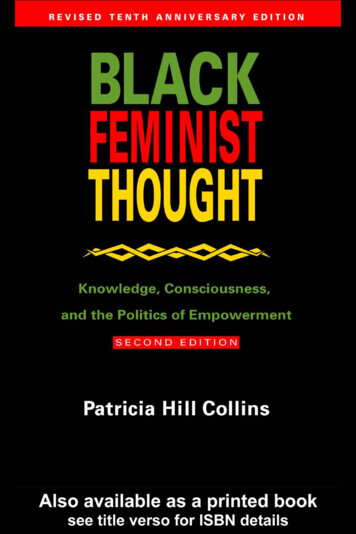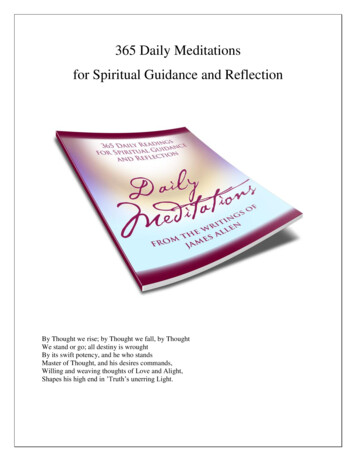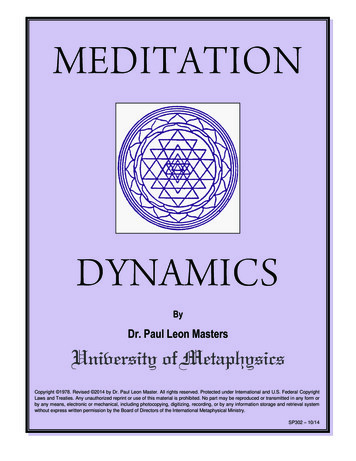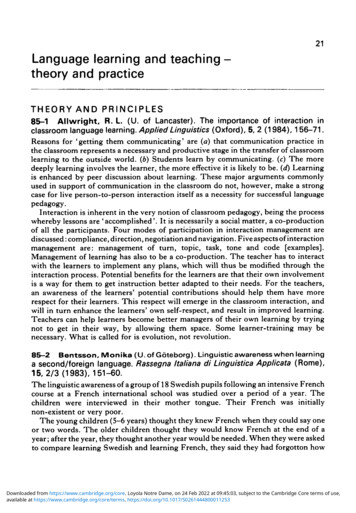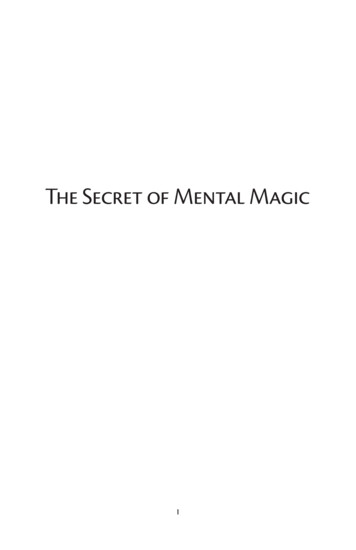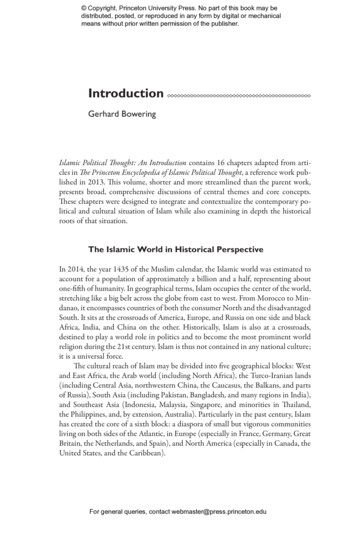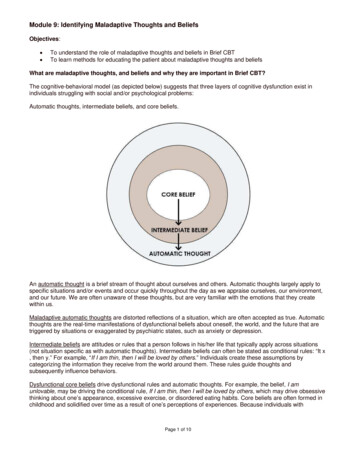
Transcription
Companion WorksheetI THOUGHT IT WAS JUST ME (BUT IT ISN’T):MAKING THE JOURNEY FROM “WHAT WILL PEOPLETHINK?” TO “I AM ENOUGH” (Gotham, 2007)Brené Brown, Ph.D., MSWRECOGNIZING SHAMEThe first element of shame resilience is recognizing shame and understanding our triggers. Menand women who are resilient to shame have this capacity. This enables them to respond to shamewith awareness and understanding.When we can’t recognize shame and understand our triggers, shame blindsides us. It washes over us,and we want to slink away and hide.In contrast, if we recognize our shame triggers, we can make mindful, thoughtful decisions abouthow we’re going to respond to shame – before we do something that might make things worse.Shame has physical symptoms. These might include your mouth getting dry, time seeming to slowdown, your heart racing, twitching, looking down, and tunnel vision. These symptoms are differentfrom one person to the next. So if you learn your physical symptoms, you can recognize shameand get back on your feet faster.I physically feel shame in/on my.My shame symptoms include:I know I’m in shame when I feel.If I could taste shame, it would taste like.If I could smell shame, it would smell like.If I could touch shame, it would feel like.1 2019 Brené Brown LLC. brenebrown.com
EXPLORING TRIGGERS AND VULNERABILITIESOur unwanted identities dictate our behavior every day. It’s worth it to figure them out and getreal about them. Often, you’ll see that the perceptions you want to have and want to avoid aretotally unrealistic.To get at shame triggers, figure out how you want to be perceived around a specific identity. Sofor example, with regards to motherhood, one might want to be perceived as calm, knowledgeable,educated and not perceived as overwhelmed, stressed out, too ambitious, or unable to balance careerand mothering. When we write these down and look at them, we understand the perceptions thatmake us vulnerable to shame. In the process, we learn a lot about ourselves.To start, pick a shame category (body, work, motherhood, parenting, etc.)Then, answer the following questions.3-5 Ideal IdentitiesI want to be perceived as:01.02.03.04.05.3-5 Unwanted IdentitiesI do NOT want to be perceived as:01.02.03.04.05.2 2019 Brené Brown LLC. brenebrown.com
Looking at your list of unwanted identities, answer the following questions:Unwanted Identity 1.01. What does this perception mean to me?02. Why is it so unwanted?03. Where did the messages that fuel this identity come from?Unwanted Identity 2.01. What does this perception mean to me?02. Why is it so unwanted?03. Where did the messages that fuel this identity come from?Unwanted Identity 3.01. What does this perception mean to me?02. Why is it so unwanted?03. Where did the messages that fuel this identity come from?Unwanted Identity 4.01. What does this perception mean to me?02. Why is it so unwanted?03. Where did the messages that fuel this identity come from?Unwanted Identity 5.01. What does this perception mean to me?02. Why is it so unwanted?03. Where did the messages that fuel this identity come from?3 2019 Brené Brown LLC. brenebrown.com
Looking at your list of unwanted identities, complete the following sentence:If you label me and reduce me to this list of unwanted identities, you will miss the opportunityto know that I’m complex and that I have many strengths, including:01.02.03.STRATEGIES OF DISCONNECTION01. We have learned to move away by withdrawing, hiding, silencing ourselves and secret-keeping.02. We have also learned the strategy of moving toward. This can be seen when we attempt to earnconnection by appeasing and pleasing.03. We have developed ways to move against. These include trying to gain power over others,and using shame to fight shame and aggression.Reference: Hartling, L., Rosen, W., Walker, M., and Jordan, J. (2000) Shame and humiliation: From isolation to relationaltransformation (Work in Progress No. 88). Wellesley, MA: The Stone Center, Wellesley College. To learn more about thework being done at the Stone Center and the Wellesley Centers for Women, visit www.wcwonline.org.I use the strategy of “moving away” when:I’m most likely to “move away” with:I use the strategy of “moving toward” when:I’m most likely to “move toward” with:I use the strategy of “moving against” when:I’m most likely to “move against” with:4 2019 Brené Brown LLC. brenebrown.com
CONNECTINGWe are wired for connection. It’s in our biology. As infants, our need for connection is about survival.As we grow older, connection means thriving – emotionally, spiritually and intellectually. Connectionis critical because we all have the basic need to feel accepted and to believe that we belong and arevalued for who we are.As you work through I Thought It Was Just Me, remember to reach out and stay connected.I recommend reading the book with a trusted friend or family member.As you make this journey, I’ll leave you with this affirmation. It’s something that I try to rememberas I travel my path.5 2019 Brené Brown LLC. brenebrown.com
As you work through I Thought It Was Just Me, remember to reach out and stay connected. I recommend reading the book with a trusted friend or family member. As you make this journey, I’ll leave you with this affirmation. I
